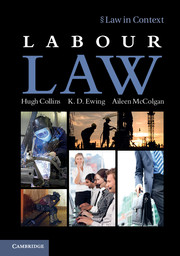Book contents
- Frontmatter
- Contents
- Preface
- Acknowledgments
- Table of cases
- Table of statutes
- Table of statutory instruments
- Table of European Union instruments
- Table of ILO instruments
- Table of other international instruments
- Abbreviations
- Part I Introduction
- 1 Nature and sources of labour law
- 2 Globalisation and labour law
- Part II The contract of employment
- Part III Statutory regulation of the employment relationship
- Part IV Collective labour rights
- Part V Termination of employment
- Index
- References
2 - Globalisation and labour law
from Part I - Introduction
- Frontmatter
- Contents
- Preface
- Acknowledgments
- Table of cases
- Table of statutes
- Table of statutory instruments
- Table of European Union instruments
- Table of ILO instruments
- Table of other international instruments
- Abbreviations
- Part I Introduction
- 1 Nature and sources of labour law
- 2 Globalisation and labour law
- Part II The contract of employment
- Part III Statutory regulation of the employment relationship
- Part IV Collective labour rights
- Part V Termination of employment
- Index
- References
Summary
Introduction
We begin this chapter with a child's school blazer. In a study on the role of trade unions in small businesses by one of the authors of this book, an interview was conducted with an employer in a town in the northwest of England. The business in question had previously manufactured school blazers, but now imported them to sell on to retail stores. In as good an illustration of the process of globalisation as any, the businessman explained that:
[T]he actual yarn starts in Kilkenny in southern Ireland, produced by a company…which is American. And it's then shipped to Ashton-under-Lyne where it's woven by a company who are Japanese. Once it's woven, it then goes back to Mansfield to the finishing and dyeing plant where they finish and dye it and ship it to Burma for us…They make it there and it's made by Burmese workers. The factory is owned by the Chinese and it's over-managed by the Koreans and then it comes back to us as a finished garment.
This simple garment thus has the input of the capital and labour of at least seven different countries. Even then, before it comes back to ‘us’, it will of course have to be shipped, and that again could involve the input of several shipping companies, with owners in yet other countries, the ships registered in other countries still, with crews recruited from yet others. And we have not started to work out the source of the buttons and labels.
- Type
- Chapter
- Information
- Labour Law , pp. 45 - 90Publisher: Cambridge University PressPrint publication year: 2012



